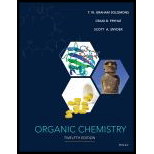
Concept explainers
Interpretation:
Mechanism for biosynthetic steps involving  and water to explain how two cyclization steps could occur, is to be written.
and water to explain how two cyclization steps could occur, is to be written.
Concept introduction:
Electrophiles are electron deficient species that have positive or partially positive charge. Lewis acids are electrophiles that accept electron pair.
Nucleophiles are electron rich species that have negative or partially negative charge. Lewis bases are nucleophiles that donate electron pair.
Free radical is an atom, molecule, or ion that has an unpaired electron, which makes it highly chemically reactive.
Substitution reaction: A reaction in which one of the hydrogen atoms of a hydrocarbon or a
Elimination reaction: A reaction in which two substituent groups are detached and a double bond is formed is called elimination reaction.
Addition reaction: It is the reaction in which unsaturated bonds are converted to saturated molecules by the addition of molecules.
Vanadium complexes are present in water bodies and they are used to convert halide anions into cations in presence of hydrogen peroxides. These enzymes are known as halo peroxidases.
These vanadium complexes were discovered in the aquatic animals.
Want to see the full answer?
Check out a sample textbook solution
Chapter 21 Solutions
EBK ORGANIC CHEMISTRY
- Alkyl halides can be reduced to alkanes by a radical reaction with tributyltin hydride, (C4H9)3SnH, in the presence of light (hv). Propose a radical chain mechanism by which the reaction might occur. The initiation step is the light-induced homolytic cleavage of the Sn-H bond to yield a tributyltin radical.arrow_forwardWrite a mechanism for the hydrolysis of the nitrogen mustard bis(2-chloroethyl)- methylamine.arrow_forwardUnder milder temperatures than what is needed for dehydration, strong acids catalyze the self-condensation of 1-propyl alcohol to give di-n-propyl ether. The mechanism differs from that of today's reaction in that the protonated alcohol undergoes an Sn2 rather than an Sn1 reaction. Write the mechanism for the acid catalyzed condensation of ethyl alcohol to give diethyl ether. Make sure the mechanism includes protonation, Sn2, and deprotonation.arrow_forward
- Hydrocarbon A has the molecular formula C14H10C12. It absorbs eight molar equivalents of any hydrogen isotope using a Nickel catalyst. When subjected to ozonolysis, Compound A yields oxalic acid and the chiral chloropentane dioic acid. Write the reactions and propose a structure for A.arrow_forwardPlease don't provide handwritten solution....arrow_forwardFor the following compound, predict three Phase 2 reactions possible at the nucleophilic site in the molecule. You will need to draw the structures for the products rather than naming the products. ОНarrow_forward
- 8a)Provide mechanisms for the following reactions:arrow_forwardAldehydes and ketones react with thiols to yield thioacetals just as they react with alcohols to yield acetals. Predict the product of the following reaction, and propose a mechanism:arrow_forwardOne frequently used method for preparing methyl esters is by reaction of carboxylic acids with diazomethane, CH2N2. The reaction occurs in two steps: (l) protonation of diazomethane by the carboxylic acid to yield methyldiazonium ion, CH3N2+, plus a carboxylate ion; and (2) reaction of the carboxylate ion with CH3N2+. (a) Draw two resonance structures of diazomethane, and account for step 1. (b) What kind of reaction occurs in step 2?arrow_forward
- When aniline, C6H5NH2(Kb=7.41010) , reacts with a strong acid, its conjugate acid, C6H5NH3+, is formed. Calculate the pH of a 0.100 M solution of C6H5NH3+ and compare it with the pH of acetic acid (Ka=1.86105) .arrow_forwardThe triple amine in an acidic medium does not give a transition n→o * Explain why?arrow_forwardA graduate student was studying enzymatic reductions of cyclohexanones when she encountered some interesting chemistry. When she used an enzyme and NADPH to reduce the following ketone, she was surprised to find that the product was optically active. She carefully repurified the product so that no enzyme, NADPH, or other contaminants were present. Still, the product was optically active. If this reaction could be accomplished using H2 and a nickel catalyst, would the product be optically active? Explain.arrow_forward
 Organic ChemistryChemistryISBN:9781305580350Author:William H. Brown, Brent L. Iverson, Eric Anslyn, Christopher S. FootePublisher:Cengage Learning
Organic ChemistryChemistryISBN:9781305580350Author:William H. Brown, Brent L. Iverson, Eric Anslyn, Christopher S. FootePublisher:Cengage Learning

 Chemistry: Principles and ReactionsChemistryISBN:9781305079373Author:William L. Masterton, Cecile N. HurleyPublisher:Cengage Learning
Chemistry: Principles and ReactionsChemistryISBN:9781305079373Author:William L. Masterton, Cecile N. HurleyPublisher:Cengage Learning Introduction to General, Organic and BiochemistryChemistryISBN:9781285869759Author:Frederick A. Bettelheim, William H. Brown, Mary K. Campbell, Shawn O. Farrell, Omar TorresPublisher:Cengage Learning
Introduction to General, Organic and BiochemistryChemistryISBN:9781285869759Author:Frederick A. Bettelheim, William H. Brown, Mary K. Campbell, Shawn O. Farrell, Omar TorresPublisher:Cengage Learning Chemistry: The Molecular ScienceChemistryISBN:9781285199047Author:John W. Moore, Conrad L. StanitskiPublisher:Cengage Learning
Chemistry: The Molecular ScienceChemistryISBN:9781285199047Author:John W. Moore, Conrad L. StanitskiPublisher:Cengage Learning





